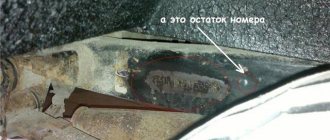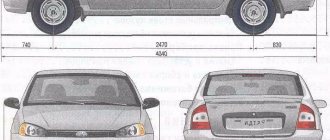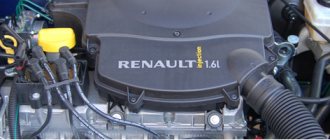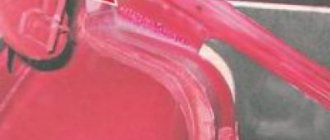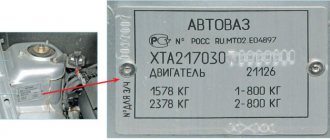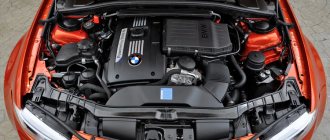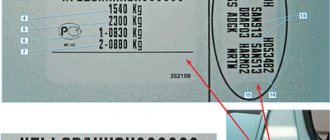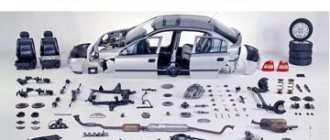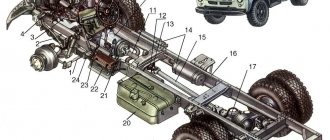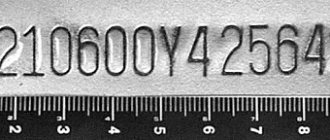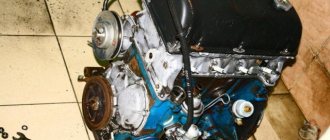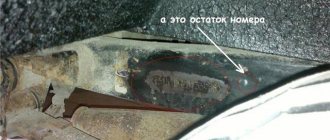- Where can I find my car's VIN code?
- What information can be found by VIN code?
VIN (Vehicle identification number) is a unique vehicle identification number, which encrypts complete information about its technical characteristics, year of production, manufacturer, etc. This code consists of 17 characters, which are structured into 3 parts - World Manufacturer Index (WMI), descriptive (VDS) and distinctive (VIS) parts. Inexperienced car owners often wonder how to find out the VIN of a car or where to find it. In our article we will try to cover this issue in as much detail as possible.
What is a car's VIN number?
Thanks to the presence of a VIN code, the car can be quickly checked for theft, that is, this combination of numbers acts as a kind of passport and protection of the equipment.
And if problems arise with the code (for example, during an accident), then this can provoke very unpleasant consequences for the car owner. It is important to have an idea of where the body number is located in each specific case.
Depending on the vehicle brand, country of origin, manufacturer and other characteristics, it is present in different places and is often duplicated, minimizing the risk associated with characters being interrupted by attackers.
What is the use of a chassis number when buying a car?
Checking documents for authenticity is important when buying a car, in particular if we are talking about a foreign car. The VIN also allows you to check the car history in detail; our CARFAX service will help you check the history of cars from the USA and Europe. If the data in the history matches the information in the documents for the car, then you can buy without any problems.
Criminals often clone the chassis number and use it to steal and launder vehicles. In documents and on a stolen vehicle, the manufacturer's vehicle identification number will be replaced by an incorrect, but already occupied VIN. Therefore, before purchasing, it is important to check the vehicle's VIN for signs of substitution. If even the slightest doubt creeps in, check the VIN number in the CARFAX database.
How to find VIN
In the vast majority of cases, the code is located:
- Under the hood;
- In the place where the hood and windshield “meet”;
- On the floor near the driver's seat;
- On the driver's or passenger's door pillar;
- At the windshield (bottom);
- On the spar, cylinder block;
- On the partition that separates the engine and the interior.
These elements are most protected from damage in an accident, which means that in most situations the code should not be affected.
Where is the VIN number on Russian cars?
On Lada, the VIN code can often be found in the engine compartment. If there is none here, you should look at the bottom of the air supply box.
In addition, the VIN may be on the right mudguard pillar (top) or on the shield amplifier, and may also be present on the panel lining the radiator. The location will depend, of course, on the model.
- If we talk about cars from the Ulyanovsk plant, the picture there is similar. The year of production plays an important role here - depending on this, the necessary information should be looked for, including on the hinges of the driver's or passenger's door. "Patriot" hides the VIN under the hood or in the front door opening.
- With old cars the situation is more complicated. In some cases, the VIN code is missing altogether. In order to make your life easier, you need to delve into special sites on the Internet and find out where the body number was placed for a specific model of a particular year of manufacture.
How to check a car by chassis
Previously, it was impossible to check a car from Japan online. Since 2022, the functionality of the Autocode service has solved this problem. The test can be completed within 2 minutes. For this:
- above the search bar, select the “Body (for Japanese)” button;
- Enter the available values into the search bar and get brief information about the car;
- pay for the full report (399 rubles) and get complete information about the car.
The resulting report will contain all the necessary information. You will receive a link to the report by email.
Where is the VIN number for foreign cars?
To protect cars from theft, foreign manufacturers often duplicate the VIN in several places. For Germans, its location depends on the year of manufacture - this is especially true for BMW.
Americans place the code on the windshield - where it “meets” the hood. The VIN may also be present in the doorway and a number of other places that are not always accessible.
Asian manufacturers often place the number on a small plate located on the left front door pillar (lower part). In addition, the combination of numbers may be present in the engine compartment and cylinder head.
Asian encoding
Not the entire automotive industry in Eastern countries recognizes ISO standards, but the 17-character designation is used. Although there are identification numbers with a combination of 12 characters.
Asian manufacturers use the lower part of the B-pillar for the main plate and the outer part of the bottom under the front seats for the additional one. Very rarely, the VIN code is stamped in the engine compartment.
The body or VIN number is indicated in the technical passport of the vehicle. When buying a car on the secondary market, you can independently check it for theft using any available database on the Internet.
It is definitely worth checking whether the 17 symbols indicated in the PTS match those printed on the main plate. Even if you have to climb into the hatch under the right rear seat, where the body number of a Mercedes is often located.
After all, it is better to immediately clarify all identification codes and check the future purchase than to later have troubles with state inspectors, proving your non-involvement in the theft.
Deciphering the VIN code
It’s not enough to find the code; I’d also like to be able to read it. The combination of symbols cannot be random - each has its own meaning:
- The area where the vehicle was manufactured.
- The state is in it.
- Car manufacturer. If the number 9 is present in this line, then the manufacturer produces no more than five hundred cars per year.
- Information about the car model, body type, engine and equipment (numbers 4 to 8).
- The ninth digit concerns manufacturers from China and the USA.
- The tenth indicates the model year of the vehicle.
- The eleventh tells about the plant where it was assembled.
The remaining symbols can indicate the sequence according to which the car was assembled on the assembly line.
Decoding the body number
Domestic manufacturers and some representatives of the Asian automobile industry prefer to encrypt information about the car the old fashioned way with a digital code, which contains from 9 to 12 digits.
Part of this sign - the first 4 to 6 characters - contains information about the make and type of car body. The remaining numbers indicate the factory serial number of the vehicle itself.
Method of applying VIN number
The combination of characters is written on one line as a solid line, that is, without spaces.
An option of two lines is acceptable, but there should also be no spaces between characters.
- With the exception of the last four positions, VIN is a combination of numbers and Latin letters.
- No Cyrillic! I, O and Q are also missing from the letters used, since they look very similar to the numbers 1 and 0.
- The number of characters used when creating a VIN code is also strictly regulated - there must be 17.
VAZ engine number
The marking on the engine is applied to a special area of the cylinder block. The labeling process is mechanized.
On engines produced before December 1974 (VAZ-2101, VAZ-2102, VAZ-2103), the marking area was located on the front upper end of the cylinder block.
Since the second half of 1975, the marking area on engines has been located on the tide of the block, to the left in the direction of travel, above the oil filter. On engines manufactured from December 1974 to July 1975, markings are found on both sites. Since July 1975, at the previous location of the engine number, only the engine technological number, consisting of three digital characters, has been applied.
Photo. General view of the number applied to the engines of VAZ-2101-VAZ-2107 cars.
Markings are applied to engines of all models, except the VAZ-2108, using an automatic German numbering machine, as well as a VAZ KVTs numbering machine. On the engines of VAZ-2108 cars, markings are applied with a numerator.
Rice. Engine numbers, made on a metal plate with a numerator: a) - ; b) — VAZ KVTs; V) - . The sizes of this font and stamp imprints are shown in the figures.
Rice. Custom non-guest font options
Rice. Sign imprints made on a metal plate
On engines of VAZ-2108 and VAZ-2109 cars and their modifications, the number is located on the upper part of the rear wall of the block on the flywheel side, to the left in the direction of travel (close to the distributor breaker).
The surface of the site is subjected to mechanical processing on a milling machine before marking is applied. On the engine blocks of VAZ-2101, VAZ-2102, VAZ-2103, VAZ-21011, VAZ-2104, VAZ-2105, VAZ-2106, VAZ-2107, VAZ-2121 and their modifications, not only the platform for markings, but also surfaces for the oil filter and fuel pump.
The location of the number on the site relative to its conventional center or boundaries is not regulated.
The serial number on engines, starting with the VAZ-2108, must be between two asterisks (dividing marks). The distance between the outer digits and asterisks on each side, as well as the distance between individual markings, should be no more than half the width of the digit.
From 1984 to 1985, on VAZ-2108 car engines, the placement of signs in the number was carried out in two lines, then from 1986 - in one line.
Photo. General view of the number applied to the engines of VAZ-2108 cars and their modifications
Rice. Parameters and location of characters in the number designation: a - in two lines; b - in one line
The year of engine manufacture is indicated by letters of the Latin alphabet. In the number designation (in particular, on VAZ-2108 engines and its modifications), the letter indicating the year of manufacture is located immediately after the model index, and the number looks like this: “2108f* 0000001*. The letter F indicates that the engine was manufactured in 1985.
List of letters of the Latin alphabet used to indicate the year of manufacture of the engine.
Table.
Year Designation Year Designation 1980 A 1991 M 1981 B 1992 N 1982 C 1993 P 1983 D 1994 R 1984 E 1995 S 1985 F 1996 T 1986 G 1997 V 1987 H 1998 W 1988 J 1999 X 1989 K 2000 Y 1990 L In 1985-1986 all engines of VAZ-2108 cars and its modifications contained a letter in the number indicating the year of manufacture. Since 1987, it began to be applied in the number not to all engines, but mainly to those that entered the domestic market, since car importing countries asked not to include a letter of the Latin alphabet indicating the year of manufacture in the designation of the engine number. Abroad, the presence of a letter in the number immediately after the model was perceived as a modification of the main model. In this regard, since 1987, the plant practically ceased to indicate the year of manufacture on VAZ-2108 engines, since there was no clear distinction between products that were to be sold on the domestic market and those that would be sold abroad.
According to available information, until 1987, the engine number was indicated by seven characters. After the production of 10 million cars, the problem of switching to eight-digit numbering arose. However, this is not easy to do due to the need to completely replace the marking equipment.
Therefore, it was decided from the beginning of 1987 to start engine numbering again (as in 1970) from “zero”. In order not to confuse the year of manufacture of the engines of the old family of VAZ cars, you should pay attention to the information about the casting date of the cylinder block. It is located on the right side of the engine block, is laid when the block is cast and has the following appearance:
D VAZ 01 07 85 N 2106
D (A, B, C, F, H) – used equipment; VAZ – manufacturing plant; 01 07 85 - date of manufacture of the engine block; (K, N) – brigade code; 2106 – designation of the cylinder block model.
The block casting date almost always corresponds to the engine release date, since the difference between the block casting and the release of the finished engine does not exceed 15-20 days.
The strength of stamping numbers with numerator stamps is regulated by engine marking technology. In this case, the magnitude of the stamp indentation force is 560 N, the depth of indentation (implementation) of the stamp into the metal is no more than 0.3 mm.
In the numerator, the stamps are ring disc. All seven disks, assembled together, form a “package” in which the disks are assembled and arranged in such a way that their working surfaces form a sphere of a certain radius. When marking an engine, the sphere seems to roll over the surface of the pad on the block, leaving imprints of the stamps in accordance with the order of the stamps in the package, the totality of which forms the engine number. The platform is run in the same way when applying the engine model index. Before entering the next number in the numerator, the stamp is changed by rotating it around its axis and bringing the next number to the level of the contacting surfaces between the stamp and the pad. Changing stamps and bringing the numerator to the desired level are carried out automatically.
The numerator has finger-type stamps. They are secured and held by a rotating head (chuck). To stamp the number and bring the head to the surface of the engine block, it turns alternately in one direction or another around its axis, bringing the required stamp to the site. At the moment of complete and correct alignment of the contact surfaces, some branding occurs forward towards the surface of the block, and the desired brand comes to the level of direct contact with the engine block. The extension of the mark ends with direct contact and the formation of an impression on the block area. Subsequently, the rotating head moves slightly from left to right relative to the block and at the same time the stamp is changed by turning the head and placing a new one according to the programmed program. Everything repeats itself again. In this way, all the markings on the engine block are stamped, after which the rotary head completely moves away from the processed block.
Markings are applied to engine blocks immediately before their assembly.
Separate units - spare parts intended for sale through retail chains or workshops - do not have numbers stamped on them. They only have a technological number located on the front end of the engine block and consisting of three characters, which serves for the correct selection of pistons.
If individual characters are incorrectly applied in the engine marking designation (problems in the operation of numberers associated with untimely replacement of the brand), they are eliminated. The area of metal on which the sign to be destroyed is located is punched. Then the desired sign is stamped by hand, and a similar stamp is used. At the factory, one, the last two (when changing in the tens number), the last three (when changing hundreds) digits, etc. can be corrected. If the entire number is incorrectly applied, it is cut off with an emery wheel of a grinding machine to the depth of the relief image and then stamped new number. If only part of the sign(s) is displayed in relief, then the non-displayed part is finished off. The plant maintains a file cabinet in which engine numbers with corrected errors are recorded.
Techniques of car thieves
The places where the VIN is located are not very convenient to read. Hijackers sometimes try to take advantage of this - they “edit” a number that is located in a more or less comfortable place, “forgetting” that it may be located somewhere else. As a rule, naive clients do not look there and get away with deception.
The technique of interrupting numbers is an art, although it is punishable by law. But there is also very crude work that is easy to detect: new symbols are simply knocked out on top of similar old ones. Such a sign still looks suspicious - it has an excessive relief and is not always easy to read.
The original code cannot contain:
- Differences in the font used;
- Putties;
- Weld seams;
- Various depths of embossed characters;
- Various panel thicknesses.
If any of the above points are present, this should at least alert you.
The conclusion in this case suggests itself: when purchasing a car second-hand, you need to study all the places where the VIN may be present, and also carefully consider all the symbols present.
There should be no scratches or dents near the plate - this means that no one tried to unscrew it. Knowing where the body number is located and exactly how it should look, you can protect yourself from purchasing a problematic car.
